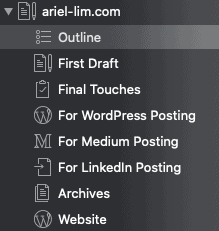Today marks the last day of the 30-day challenge I took for myself. My goal was to publish an article a day—a simple yet very challenging task.
As I reviewed my bullet journal, I complained at least 3x in the first two weeks.
I was running out of stuff to write about. I also find that it was taking me quite a while to finish the final article as it involves me taking screenshots and making sure everything flows smoothly.
But by the 3rd week I was getting into a rhythm.
Writing seems to be a little bit easier. But time is still my enemy. It takes me between 1-4 hours to finalize an article, depending on how in-depth it is.
By the fourth week, i’ve started looking forward to my new routine. What I did, or tried to do most of the time, is wake up earlier than usual. Nothing too crazy like 5:30 am or whatever “billionaire” routines that you read on the internet. Just maybe 30 minutes earlier.
Then, this is something I noticed that helped a lot, I dont look at my phone or any notifications that appeared while i was sleeping. I don’t read any email. I don’t look at any social media apps.
The only thing I think of are two things: which method will I use to brew my coffee (I typically use a V60 but sometimes I opt for an Aeropress) and what do I write about.
Looking back, around 70% of the articles I published the last 30 days are all new. Meaning, i’ve had to go through the research, writing, editing, and adding the final touches to all of them. The 30% were either repurposed from other content I’ve written before, or some already have drafts so i just had to finalize them.
Writing Process
I follow a process that I read from one of the newsletters I received early last year. I can’t remember where it’s from but it goes something like this:
- Outline
- First draft
- Final touches
- Proofreading/publishing
The original article I read used those 4 distinct phases as a task you do each day. Let’s say on Monday, you simply write the outline to the article you want. Think about the title, which headers and subheaders you’ll be using. The next day, you write your first draft. Just write whatever comes to mind. No editing. Just put words to paper.
On Wednesday, you put the final touches on the article. You add some images, screenshots, etc. Then leave it once it’s done. The next day, that’s when you give it a final look. Adjust any copy or anything that needs to be finalized. Then, you publish and distribute.
I somewhat adopted that into my own workflow. Basically in Ulysses, I have different groups for that writing process and my own distribution process. It looks like this…

Instead of following that process one day at a time, I took the concept and made it into my workflow. For example, whenever I’m in the mood to write some outlines, I do a couple in one sitting. Sometimes, when I’m at the grocery waiting in line to pay, I put out my phone and start outlining an article.
Then, whenever I get a chance to sit on my computer, I expand those into articles. That’ll be my first draft. Once I’m done with those, I move them over to the Final Touches stage. That’s then I add images and screenshots, maybe even record a video.
Then this is almost always the case— I do the publishing/scheduling at least 1 day after I finished the final touches. That way, I can look at the article with fresh eyes. I can spot stuff I missed more easily.
The only thing that I wasn’t able to do more during this 30 days is follow my own distribution process. The writing already takes a lot of time and the distribution process I had planned will probably involve an extra hour or two per article. So, that was something I needed to do better in the future.
Results
Since I didn’t do much distribution elsewhere apart from basic sharing on social media, I’m focusing on organic traffic only.
My organic traffic grew by 4.93% from December. And that’s comparing 31 days in December with only 30 days in January. I’ll most likely update this again on the first week of February to reflect the same monthly comparison.
And as I’ve said in the past before, traffic by itself is useless. What matters is how that traffic affects your business as a whole. In my case, my website is not my primary source of income. So this is relatively okay. I know that from the start so I didn’t focus on generating leads.
But, having said that, I still got a 300% increase in leads from December.
Well, the number is a bit misleading since I only have two new leads last December, but got 8 new ones this month. All of these are newsletter subscribers, by the way.
Nothing too fancy. Just regular growth. Slow and steady.
For a long time, this website has been in the back burner. I didn’t spend a lot of time growing my traffic nor generating leads and revenues from it. I write and publish whenever i think of doing it. For example in 2019, I only published 16 articles last year (2019).
But that will all change this year. That’s why I took this 30-day challenge.
It’s a great starter project for 2020.
I honestly didn’t have expectations on traffic, much more on leads. All I wanted was to challenge myself to write more.
Plans for the Upcoming Months
Now that I’ve completed the 30-day challenge, I still plan to write more content, but would dial it back to once a week. Then, as I mentioned above, I’ll do better in the distribution aspect as that’s what’s going to affect the outcome and bring in the results.
I follow the OKR principle— so I have my own Q1 goals. I wrote them on Post-it’s and stuck them to my Bullet Journal. Underneath each post-it are my scores for the week. That way, I get to track my progress. So far, I have a score of 0.5.
If you’re familiar with OKRs, that’s a fairly okay number. If I have a 0.8-1 score, my goals are probably not stretched and way too easy to achieve. If my scores are lower, I could have set impossible goals. So, I think I’m right in the middle.
It’s a long road ahead. We’re one month down in this new year. I hope that whatever resolution or goals you wished to accomplish, you are close to hitting them.







